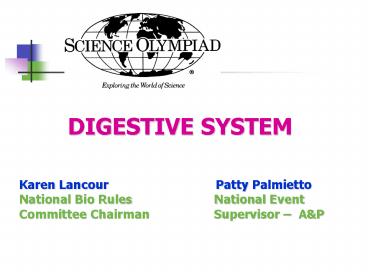DIGESTIVE SYSTEM PowerPoint PPT Presentation
1 / 22
Title: DIGESTIVE SYSTEM
1
- DIGESTIVE SYSTEM
- Karen Lancour Patty
Palmietto - National Bio Rules National Event
- Committee Chairman Supervisor AP
2
DIGESTIVE SYSTEM digest foods extracellular
(outside of cell) in digestive canal
3
BASIC PROCESSES OF THE DIGESTIVE SYSTEM
- INGESTION -- intake of food
- DIGESTION breakdown of food
- Mechanical Digestion physical breakdown
- Chemical Digestion chemical breakdown of
macromolecules to monomers - Absorption -- Transport of the products of
digestion into the blood - Defecation -- Elimination of undigested waste
4
ORGANS OF DIGESTIVE TRACT (Mouth to anus)
- Mouth - Chewing, Digestion begins
- Pharynx - Swallowing
- Esophagus - Transports food to stomach
- Stomach - Storage of food, Digestion of protein
- Small Intestine - Majority of digestion and
absorption of food - Large Intestines - Absorption of water, Waste
storage - Anus - Elimination of waste
5
ASCESSORY ORGANS
- SECRETE FLUIDS INTO DIGESTIVE TRACT
- Salivary Glands - Secrete salivary amylase
- Liver - Produces bile
- Gallbladder - Storage of bile
- Pancreas - Secretes pancreatic amylase and other
digestive enzymes
6
MOUTH
- Opens to outside to facilitate feeding
- Aids in preparation of food for digestion
- Foods are broken down mechanically by chewing
- Saliva is added as a lubricant from the
auxiliary saliva glands - Saliva contains amylase, an enzyme that digests
starch - Serves as an organ for speech and pleasure
- Includes cheeks, lips, tongue, palate, teeth
primary secondary
7
TEETH
- Incisors (8) for biting food
- Canines (4) - for grasping and tearing food
- Bicuspids (8) for grinding and crushing food
- Molars (12) for grinding food
8
ESOPHAGUS
- a simple tube between the mouth and stomach
peristalsis aides in swallowing
9
STOMACH
10
STOMACH
- Enzyme digestion of proteins initiated
- Foods reduced to a liquid form
- Walls lined with millions of gastric glands
- Several kinds of cells in gastric glands
- Very little absorption from stomach some water,
ethanol, drugs as aspirin, and certain ions
11
SMALL INTESTINE
- most of chemical enzymatic digestion occur
- almost all nutrients are absorbed
- Accessory glands liver, gall bladder, and
pancreas provide secretions to assist with
chemical enzymatic digestion
12
LIVER and GALL BLADDER
- Liver - provides bile salts to the small
intestine, which are critical for digestion and
absorption of fats. - Gallbladder stores bile
13
PANCREAS
- Pancreas - provides digestive enzymes to the
small intestine which are critical for digestion
of fats, carbohydrates and protein.
14
LARGE INTESTINES
- Colon
- liquid residue mainly water with undigested
materal - water is absorbed,
- bacterial fermentation takes place
- feces are formed.
- Rectum collects undigested waste
- Anus expels undigested waste muscles to
control exit and prevent leakage.
15
DIGESTIVE PROCESS
- Ingestion intake of food
- Digestion breakdown of food bit by bit into
molecules small enough to be absorbed - Mechanical Digestion physical breakdown
of food - Chemical Digestion chemical breakdown of
macromolecules to monomers - Absorption transport of productions into the
blood - Elimination (Defecation) - elimination of
undigested waste
16
CHEMICAL DIGESTION
- CARBOHYDRATES
- PROTEIN
- FATS
- NUCLEIC ACIDS
17
Common Disorders of Digestive System
- Stomach and duodenal ulcers
- Cancers of the digestive system
- Diarrhea
- Lactose Intolerance
- Hepatitis
- Crohns Disease, GERD, Diverticular Disease,
Celiac Disease (National)
18
Role of Fiber in Digestion
- Fiber is found mostly in plant
- There are two types insoluble fiber and soluble
fiber - Insoluble fiber is a type of fiber which cannot
be dissolved in water - Insoluble fiber draws water to the intestine,
increasing the bulk and softness of waste
products - Soluble fiber which can be dissolved in water
- Soluble fiber can be digested slowly and it slows
the digestive process and keeps the stomach
fuller longer leaving the body feeling full for a
longer period of time - Digestion and absorption of carbohydrates are
slower so that glucose (sugar) in food enters the
bloodstream more slowly, which keeps blood sugar
on a more even level - The slow absorption of sugar gives the body an
opportunity to regulate blood sugar levels
19
New Food Group Pyramid
- 2000 calorie diet
- Grains 6 oz daily
- Vegetables 2 ½ cups daily
- Fruits 2 cups daily
- Milk 3 cups daily
- Meats and Beans
- 5 ½ oz daily
20
Old Food Group Pyramid
21
Food Labels
- Serving Size
- Serving per container
- Calories
- Nutrients g and Daily values
- Vitamins and Minerals-
- Daily Values
- 2000 calorie diet
22
Nutritional Disorders
- Suggested in the rules
- Xerophthalmia
- Pernicious Anemia
- Scurvy
- Rickets
- Vitamin-poisoning
- Other common disorders or conditions
- Osteoporosis
- Obesity
- Anorexia
- Bulimia

